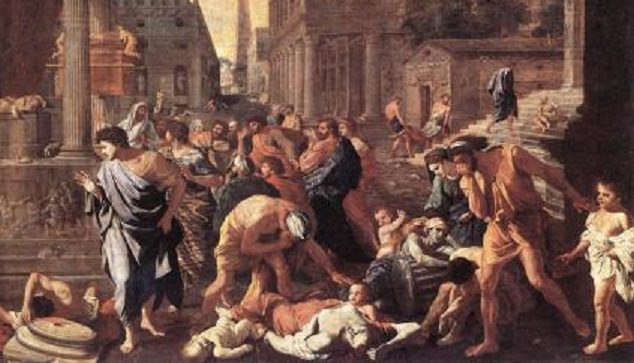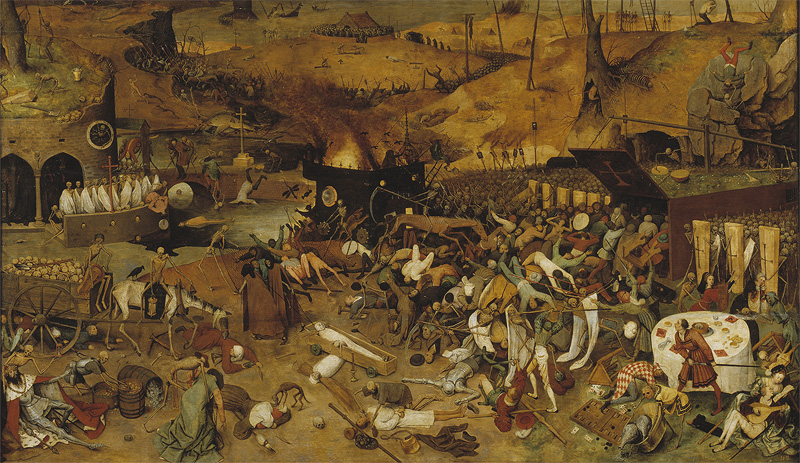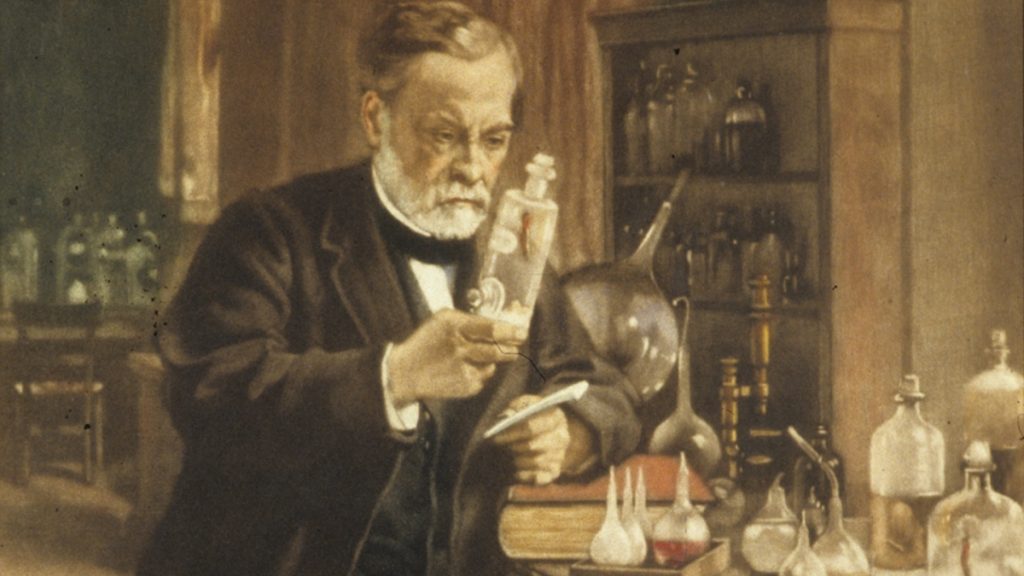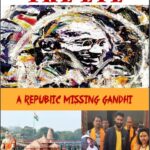Religion and Pandemics
Manoj KC 1989 EEE
Historically, pandemics have caused civilizational changes and paradigm shifts like one religion gaining the upper hand over the other, the collapse of empires and aiding colonisation. As we live through the current pandemic, a review of the social impact of major pandemics in the past will help understand how human beings responded and evolved. What we are going through now is a new experience for at least 3 generations, considering Spanish flu as the last pandemic, of which we do not have any collective memory. The perspective being explored in this article is how various pandemics affected the prominent religions of that time, the reaction, and the impact of such reaction on the people. It will also be explored if there are any notable changes in what is happening now with the scientific advances.
Religions claim absoluteness and comprehensiveness in their understanding of anything that happens and proclaim that all happens according to their “book or text”. These are in general not open for review. However, the stress or dichotomy, in a society, arising out of an extreme situation like a pandemic force changes irrespective of whether this gets updated in the books. Through the millennia, and up to almost the end of 18th century, people came up with irrational explanations for the cause and spread of pandemics. Cause of diseases were explained as wrath of God and spread through ‘bad air’ and ‘impurity’ as per the miasma theory. The name Malaria comes from “bad air”, or the usage “God bless you” when one sneezes, comes from the belief that sneezing not only spread diseases, but caused one to expel their soul. There are many such references to wrath of God in the ancient literature and scriptures. Homer’s Iliad talks about God Apollo raining plague down on the Greek army during Trojan war and according to the Bible, “pestilence” is one of the Four Horsemen of the Apocalypse. Treatise were read to people to remind them that God promises prosperity to those who kept his commandments and plagues to those who do not.

The core belief systems in a religion influenced peoples’ decision on whether to flee from the place or to stay back and help the sick. The Christian tradition with Jesus as the healer influenced Christians to tend for the sick. They believed in getting a passage to heaven in case of death from such service. Islamic tradition doesn’t believe in contagious diseases and hence their followers didn’t feel the need to avoid sick people. Their emphasis was on the well-being of the near and dear. Jewish doctrine attributed death to God’s will and hence saw less incentive in treating the sick. These core beliefs also influenced how religions were shaped and survived
History of Pandemics and its impact on religions
The earliest known pandemics was around 3000 B.C, in a Chinese village called Hamin Mangha. The epidemic spread very fast and killed the entire population of the village. This was established through archaeological evidence, but little is known of the social impact.
The Plague of Athens spread around 430 B.C, during the war between Sparta and Athens and is considered the most devastating epidemic in ancient Greece. Thucydides’ description of the plague, provided in the ‘History of the Peloponnesian War’, is the earliest record of this outbreak. Since the disease struck the virtuous and the sinful alike, people felt abandoned by God and stopped worshipping. The god Apollo was believed to be fighting on the side of the Spartans. The public morals were completely ignored since the entire population seemed to be living under a death sentence. They started spending indiscriminately and did not find meaning in leading an honourable life. The sheer contagiousness of the disease caused the public to abandon the sick and dying. The ones tending to the sick were the first ones to contract the disease and die. The dead were abandoned on the streets, places of worship and wherever they dropped dead to rot. Burials were only held at the mass grave.
Rise of Christian faith, fall of Ancient Roman Empire
A series of plagues ravaged the ancient western Roman Empire, which flourished for almost 1000 years between 800BCE to 500 A.D. Starting of as a small kingdom in Rome, they established as a powerful empire starting at the beginning of Christian Era, Under Julius Caesar. Periods of stability and prosperity was regularly interrupted by pandemics and war, eventually leading to its collapse in 476 A.D.
The first in the series was the Antonine plague that ravaged the Roman empire during A.D 165 to 180 and is believed to have been brought back by the soldiers returning from war with Parthia. An estimated 10 million people died. Since the Emperors and Pagans could provide no answer to the people about the disease or how to prevent it, people started losing faith in them. Emperor Marcus Aurelius identified the Christian faith and rituals as the cause for the wrath of God and started persecuting them. However, as the plague continued, more and more people converted to Christianity because they saw that the Christians were taking care of, and tending to the sick, as part of their belief. Secondly, they found their Roman Gods to be powerless in the face of the pandemic. This trend extended well into the Cyprian Plague which erupted in Ethiopia and spread fast to Rome, Greece and further eastward to Syria between A.D 250 and 271. At its peak it killed about 5000 people per day in Roma. The plague was named after St. Cyprian, The Bishop of Carthage. The only primary source of information on this plague is from his writing called ‘On Mortality’. These plagues along with war brought an end to the Roman empire. The nascent Christian churches gained significantly from their work amongst the sick and involvement in burial of the dead. The ones amongst them who perished attained martyrdom and eventually, the religion flourished far and wide into the Mediterranean region resulting in a transition from polytheism to monotheism.
Justinian Plague, changes in Christian practices and rise of Islam
The glory of the Roman empire had diminished completely by the time Emperor Justinian assumed power in Byzantine. However, he set out to re-establish the long-lost glory, and made good progress by capturing territory spreading from Middle East to West Europe with its capital in Constantinople. However, the Justinian Plague that ravaged Constantinople around A.D 541 to 542 and kept reappearing in different parts of the Mediterranean for another 200 years, killed a large part of the population. This was believed to be a bubonic plague with origins in China and Northeast India and reached Africa via the sea route. The Byzantine historian Procopius documented the origin and spread of the plague. The plague weakened the Byzantine empire’s economy and military, thus making it vulnerable to repeated attacks, which finally lead to the downfall of the empire. The rise in the cult of Virgin Mary and as the “Mother of God” was enshrined during this period. Festivals of Christ were turned into Festivals of Mary, as an effective shield against the pandemic. Icon worship which was part of “pagan” beliefs made a comeback in Christianity, and icons of local deities were venerated for protection against calamity. There was an erosion in belief in the power of the traditional guardians in the times of need. This included the emperor Justinian himself as he contracted the plague and fell from grace due to his personal failings. Justinian countered this by promoting his own veneration and placed himself on the same level as God, so that no one could question his piety. Overall, though the effectiveness of Christian religion and its practices were not doubted, there was a significant shift in certain practices of the religion, with the emergence of a new cult like Virgin Mary and other local icons. Secondly, the general public did not blame God directly, but the evil actions of Justinian. This was a period during which Islam started gaining prominence. Due to the nomadic nature of the Arabs, they tended to move away from the centre of disease and hence became less susceptible to the contagion. This was seen by others as the power of Islamic God to offer better protection. By about 750 A.D Islam replaced Christianity as the dominant religion in the erstwhile Byzantine empire.

Black death, Protestant Reformation and persecution of Jews
Amongst the pandemics, the most devastating and widespread one was the Black Death, which lasted for over 7 years between A.D 1346 and 1353. The disease travelled from Asia to Europe following the silk route and wiped out almost half of the European population. There are many theories of how this altered the future of Europe, with respect to advancements in science, medicine and overall prosperity. However, one thing that was very pronounced was the systematic persecution of the religious minorities by the Christians. Throughout this period, it was common to stereotype and scapegoat Jews. They were regularly blamed for conspiring with the Gods to spread the disease and for poisoning the wells with infection. Pogroms followed as and when infections spread to new cities. The main accusation was that Jews practiced their religion in a manner that was blasphemous and thereby invited the wrath of God. Self-flagellation marches were a common sight, wherein Christian believers flagellated themselves for their sins and showed their repentance to God. Flagellation also became a ritual used to build up a frenzy and would culminate in the lynching of Jews. With repeated occurrence of the plague, the Medieval Church was seen to be powerless, thus leading to their decline. The Protestant Reformation gathered momentum during A.D 1517 to 1648. In the East, Islamic leaders insisted that the plague was a gift from God, and it should be seen as another trial to be endured. That being the case, there was no need to flee the affected areas, which limited the spread. Since it was God’s gift, they did not consider it to be contagious as well. Such an approach ensured cohesiveness of Islam during the crisis.
Fall of Aztecs and Incas and Colonisation of the Americas
The 14th to the 15th century was the period of exploration of the Americas by the Europeans, for trade and conquest. They carried along a series of plagues, which killed a large portion of the indigenous population as they did not have immunity to these diseases. The conquest of Aztecs and Incas by the Spanish, and later colonisation by the British, French, Dutch and Portuguese, were made easy due to large scale death of the indigenous population due to the different plagues brought by the invaders.
Regular trade and cargo movements triggered multiple plagues throughout the 16th to the 19th Century. London was ravaged by a plague during the summer period of 1665 causing the death of 15% of the population and this was followed by the great fire of London. The Great Plague of Marseille effected France and the Russian plague during 1770 to 1772 devastated Moscow leading to the downfall of the Empress of Russia, Catherine II. Riots spread through the city and culminated in the murder of Archbishop Ambrosius, who was encouraging crowds not to gather for worship.
Impact of Scientific progress
Scientific approach and inquiry identified microbes as the cause for diseases. Germ theory replaced the Miasma theory. Though basic forms of Germ theory were proposed in the middle ages and followed through by physicians through 15th and 16th centuries, it did not gain much acceptance. The transition had to wait until the arrival of Louis Pasteur and his work in the late 18th century. It took many more years and until early 20th century to start understanding virology and develop cures accordingly.

It was after the Germ Theory was established that the flu pandemics happened. The first one occurred during 1889 – 1890, with origins in Russia and spread globally due to travel and trade. This was followed by the devastating Spanish Flu, between 1918 to 1920, affecting an estimated population of 500 million and killing 20%. The spread of Spanish flu coincided with World War 1 and aggravated the situation due to the cramped living conditions of the soldiers, fleeing population and poor war time nutrition. Since diseases spread by bacteria were understood and plagues were under control, search for a solution was more scientific. Unlike black death or the earlier pandemics, Spanish flu lead to concerted and collaborative efforts in research on virology. Pleasing the Gods or expecting solutions from the religious leaders receded from the priority and a scientific approach was resorted to.
Response of Religions to Covid19
The globally accepted approach to Covid 19 has been to consider this as a challenge that has to be tamed through scientific explorations and experiments. Religions through their leaders or spokespersons are advising people to follow science and avoid congregating at religious places. They are explaining to its followers that the Covid Virus doesn’t discriminate between religion, gender or class. Many otherwise unthinkable readjustments of core religious practices are being undertaken during this period, like changes to Easter worship or giving the Sacrament by the Catholic Church, suspension of Annual pilgrimage to Mecca, or the Thrisssur pooram. Even Sabarimala, which saw a major calibrated uprising just a year back against allowing menstruating women to enter the temple, decided to limit their rituals. This time they referred to scientific evidences and disease prediction models and not to Thanthra Samuchayam or Kuzhikattu Pacha, which they had taken all the way to even Supreme Court to fight against the constitutional provisions.
Overall, attempts to tame or please Gods through rituals have been more the exception than the norm. We had our share of such exceptions, which provided comic relief during the otherwise stressful existence. There was the Gau Mutra (Cow Urine) party organised by the Hindu Mahasabha, who attributed the pandemic to meat eating, and the Go Corona pooja lead by the minister of social justice and empowerment, Mr. Ramdas Athawale. At the Shiv-Parvati temple in Varanasi, all the Gods were provided with face masks to avoid polluted air. In the USA, such acts are being led by the evangelical groups, propagating that “faith not fear” is what will protect us from Corona virus. They have been rejecting social distancing and masks providing bizarre explanations forming “anti mask” groups.
Conclusion
A pandemic, like any other social crisis, has always been fertile grounds for conflicts, persecution, stereotyping and inventing new enemies. Religion as a communal and congregational manifestation for shared rituals degenerates easily under such crises. Religious followers are quick to discriminate against another community, based on differences in practise and declare them as the cause for wrath of God, identifying them as the sinners and enemies. In the absence of scientific and rational explanations, this was very pronounced in the early days as witnessed during the Antonine, Cyprian, Justinian plagues or the black death. Scientific advances helped dispel such irrationality to a large extent during the Spanish flu, though there was no immediate cure and the virus took its toll. As we battle with Covid 19, science has established itself firmly as the only hope for the cure. Unfortunately, the social patterns of vilification and creating the “other” to blame has not receded completely. In the absence of science, religion was a predominant contributor to conflicts during the early ages. However, it has not been the only one, the others being class, caste, race, politics and nationalism. Scientific advances have blunted the potency of religion as a standalone agency of conflict; but, it conveniently blends with the other agencies. Racist / Casteist Notions of “cleanliness” or “purity” were still used to target other communities. Spanish Flu was used to drive deep racial chasm in South Africa, cementing Apartheid. Hindus too were vilified during the Spanish flu as “unclean” and super spreaders. Cholera was regularly referred to as “Asiatic Cholera” or “Indian Cholera”, as its origin was traced to Calcutta. The Hindus and the Muslims were identified as the dirty carriers out there to infect and kill the beautiful populations of London, Vienna and Washington.
Attempts at vilification and stereotyping of the “other” happened during this Covid 19 pandemic as well. Donald Trump alluding to Covid-19 as the “Chinese virus”, the witch hunting of those who attended and organised the Tablighi Jamaats congregation in India and labelling them as Corona Jihadis standout as sad examples. As the pandemic stretches into many months, people seem to be losing their patience and ignoring the scientific calls to wear masks or follow social distancing. Citation of hurt religious sentiments, rituals and beliefs are still being used by a minority to violate these guidelines. These are surely not genuine expressions but a manifestation of political mischief. However, it is disturbing to note that the veneer of scientific temper is so thin, and a prolonged period of uncertainty and strife can be easily exploited by vested interests
Let me conclude by quoting Marx, “Religion is the sigh of the oppressed, the heart of a heartless world, and the soul of soulless conditions. It is the opium of the people”. This allusion to religion as the opiate providing palliative relief to the masses under stress, seems to be very far from being true, considering the strife religion has poured into societies reeling under devastating pandemics.













